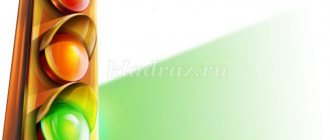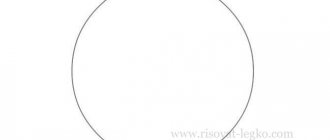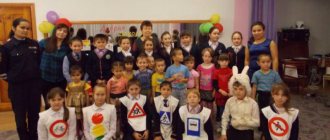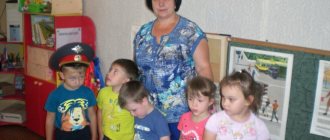Game description
Children are divided into 2 subgroups and placed perpendicular to each other. The first is steam locomotives, the second is cars. When the traffic light turns green, the “Locomotives” start moving and the “Cars” stop. At a red traffic light
The "Locomotives" stop and the "Cars" begin to move.
“Steam Locomotives” and “Cars” start moving when the traffic light turns green.
“Locomotives” and “Cars” stop at a red traffic light.
No. 6. “THE CHILDREN GO TO GARDEN”
Target:
Exercise children in running in a straight line at the teacher’s signal. Reinforce knowledge of traffic lights.
Game description
Children, at the teacher’s signal, follow each other without bumping into each other. Couples stop at a red traffic light. When it turns green, they continue driving.
Rules:
Couples start moving when the traffic light turns green.
Couples stop at a red traffic light.
Card index of didactic games on traffic rules for the senior group
Card index of didactic games on traffic rules
Senior preschool age
“Guess what sign?”
Objectives: To teach children to distinguish road signs, to consolidate children’s knowledge of the rules of the road; develop the ability to independently use the acquired knowledge in everyday life.
Material: Cubes with road signs pasted on them: warning, prohibition, directional and service signs. Game progress: 1st option. The presenter invites you one by one to the table where the cubes lie. The child takes the cube, names the sign and approaches the children who already have the signs of this group.
2nd option. The presenter shows a sign. Children find this sign on their blocks, show it and tell what it means.
3rd option. The players are given dice. The children study them carefully. Next, each child talks about his sign without naming it, and the rest guess this sign from the description.
"Traffic light"
Purpose: To familiarize children with the rules for crossing (crossing) an intersection regulated by a traffic light.
Material: Red, yellow, and green circles, cars, children's figures.
Progress of the game:
One of the players sets certain colors for the traffic lights (by overlaying red, yellow or green circles), cars and figures of children walking in different directions. The second guides cars (along the roadway) or children's figures (along pedestrian paths) through the intersection in accordance with the rules of the road. Then the players change roles. Various situations are considered, determined by the colors of the traffic lights and the position of cars and pedestrians. The player who accurately solves all problems that arise during the game or makes fewer mistakes (scores fewer penalty points) is considered the winner.
"Drivers"
Goals: Teach children traffic rules; develop thinking and spatial orientation.
Material: Several playing fields, car, toys.
Progress of the game:
Several options for simple playing fields are prepared in advance. Each field is a drawing of an extensive road system with road signs. This will make it possible to change the road situation. For example: “You are a car driver, you need to take the bunny to the hospital, get gas and fix the car. The picture of the car represents the garage where you left and where you should return. Think and say in what order you need to visit all these points so as not to violate traffic rules. And then the two of us will see if you have chosen the right path.”
“Who is the excellent pedestrian?”
Objectives: To consolidate children's knowledge about traffic rules (traffic signals, pedestrian crossing); cultivate perseverance and attention.
Materials: 2 chips and a die with the numbers 1,2,3,4,5,6. Playing field.
Progress of the game:
The first pedestrian leaves from house No. 1, the second from house No. 2. They throw the dice one by one until the first dice shows the number 1, the second the number 2. And they roll the dice again. In this case, you need to look carefully at the multi-colored pictures. In the first picture, the traffic light is red. This means that a pedestrian cannot jump to the circle after the traffic light. He stands patiently in place. The second picture shows a car. You can't cross the road, you have to wait. On the third, the traffic light is green. You can move the chip as many circles as the die shows. In the fourth picture there is a motorcyclist. We need to let him pass, stop. In the sixth picture, the traffic light is yellow. And the pedestrian can stop right at the picture itself. The seventh picture shows a traffic controller. It’s safe with him, you can go straight to grandma’s house. Whoever is the first to come to grandma without violating traffic rules wins.
"Travel by Car"
Goal: To consolidate with children knowledge of road signs and rules of conduct on the streets.
Material: Game field, chips.
Progress of the game:
The children begin to play on the playing field. When passing road signs, they stop and talk about each of them. The one who reaches the sea first wins.
"On the way to"
Objectives: To consolidate knowledge about various types of transport; train attention and memory.
Material: Pictures of cargo, passenger transport, chips.
Progress of the game:
Before the trip, agree with the children who will collect what type of transport (for clarity, you can distribute pictures of trucks and cars, you can also take specialized transport: police, firefighters, ambulance, etc.). On the way, children pay attention to the cars, naming them and receiving chips for this. Whoever collects the most wins.
"Find the right sign"
Goal: Continue to consolidate knowledge of road signs and traffic control devices.
Material: 20 cardboard cards (puzzles). Some halves of the cards depict road signs, the other halves show the corresponding traffic situations.
Progress of the game:
1st option. The presenter selects cards with signs of one type (or several types, if they are few in number). The presenter distributes halves of cards depicting the traffic situation to the children, and places the elements with signs on the table face up. Then he names the type of road signs and talks about their general meaning. After this, the presenter invites the children to find common external features of this type of sign (color, shape, etc.). Children must find the appropriate half of the card among the elements they have.
2nd option. Children divide all halves of cards with signs equally. The traffic elements are shuffled and placed face down in the center of the table. Children take turns taking cards and matching them to their own. The first person to find matching halves for all of their cards wins.
"Learning road signs"
Goal: Continue to consolidate children's knowledge about road signs and traffic lights.
Material: Cards large and small with signs.
Progress of the game:
Large cards are divided equally between the players. The presenter takes turns showing cards with road signs, the one to whom it suits takes the sign, puts it in the upper right corner and tells what the sign is called and in what situations it is used. The winner will be the one who correctly selects the signs for the situations and can explain it.
"Traffic Laws"
Objectives: To consolidate the basics of road literacy; introduce the main road signs, their classification, purpose; promote the development of attention, memory, thinking.
Progress of the game:
The teacher takes on the role of a traffic police inspector. Participants move around the playing field using a cube. If the color is green - movement is allowed, yellow - attention, red - stop - the player misses a move. If the chip lands on a field with a picture of a road sign, the participant needs to find a sign from this group in the “common bank”. The one who scores the most points wins. 1 card – one point.
"Laws of streets and roads"
Goal: To instill rules of behavior on the roads. Ability to navigate in space.
Material: Playing field, large cards - 8 pieces, figures of people and signs.
Progress of the game:
The game is divided into several options: “Hello, city!”, “How to get there, how to get through?”, “What’s the sign?”, “If you drive more quietly, you will go further.”
«Talking signs"
Goal: To consolidate knowledge of road signs and their classification.
Material: 73 cards depicting road signs, 73 cards describing the meaning of each sign and the positions of the traffic controller.
Progress of the game:
The presenter mixes cards with pictures and distributes them to the players. He keeps the cards with the text for himself. Then the presenter takes one card and reads the text. The player who has a card with a road sign corresponding to the text read places it in the middle of the table. If the numbers match, the player takes the cards for himself. The winner receives a driver's license card.
"Driving school No. 1"
Goal: To strengthen children's knowledge of the rules for crossing streets and the importance of road signs.
Material: Game field, chips, cards with signs.
Progress of the game:
Players take turns throwing the dice and moving along the playing field; on the yellow circle in front of the pedestrian crossing, they must stop and pass the move to another participant in the route. A stop is needed so that the pedestrian can first look to the left and then to the right to see if traffic is interfering with crossing the street. Anyone who did not stop on the yellow circle and took a few steps forward must return to the place where he started his last move.
"True False"
Goal: To reinforce with children the rules of safe behavior on the streets and traffic signs.
Material: Playing field, traffic signs.
Progress of the game:
Children distribute the characters in the picture, and each one talks about who is doing what - right or wrong. The winner is the one who more fully and correctly describes the behavior of the selected character.
"We are passengers"
Objectives: To clarify children’s knowledge that we are all passengers; establish the rules for boarding and disembarking from transport.
Material: Pictures of traffic situations.
Progress of the game:
Children take one picture at a time and tell what is drawn on them, explaining what to do in a given situation.
"Road ABC"
Goal: To consolidate knowledge of road signs, the ability to correctly navigate them, classify them by type: prohibitory, prescriptive, warning, informational.
Material: Cards with traffic situations, road signs.
Progress of the game:
Children choose cards for themselves, the leader gives road signs, he shows the signs one by one, the one who has the right card takes the sign and justifies his choice.
"Traffic Light and Traffic Controller"
Objectives: To clarify children’s knowledge about the work of traffic police officers (traffic police officers); explain the meaning of his gestures; teach children to correlate the traffic controller’s gestures with the color of the traffic light.
Material: Traffic controller, traffic controller stick, traffic light signs.
Progress of the game:
After the teacher’s explanation, the children take turns acting as a traffic controller, showing his gestures; the rest, depending on the position of the “traffic controller,” show the required traffic light signal.
"Road signs"
Objectives: To consolidate children's knowledge about the rules of behavior on the street; remember famous road signs; introduce new concepts: “railway train without a barrier”, “safety island”.
Material: Road signs
Progress of the game:
Read a poem to the children about a road sign; whoever guesses it gets the sign. The child who collects the most characters wins.
“Know and follow traffic rules”
Goal: To reinforce traffic rules with children; repeat the traffic light values.
Material: Illustrations of city streets.
Progress of the game:
Children are given a riddle about a traffic light, a discussion is held about the meaning of the colors of the traffic light, an analysis of situations on the road and the correct behavior of the characters.
"Behavior rules"
Goals: To reinforce the rules of behavior with children; discuss various dangerous situations that may arise when playing in the courtyard or on the street; teach necessary precautions.
Material: Cut pictures.
Progress of the game:
On the board are pictures depicting people in various situations. The teacher invites the children to look at them. Children look at these pictures, choose any one and tell them, remembering the rules of the road, what not to do and how to act.
"Pedestrians and transport"
Goal: To reinforce with children the rules of the road and the rules of safe behavior on the streets.
Material: Dice, playing field, chips.
Progress of the game:
The playing field depicts a road along which the players move with the help of chips; they have obstacles in the form of signs on their way.
When hitting these obstacles, the player returns back. Once at the “pedestrian crossing”, the player moves forward along the red arrow. The one who reaches the finish line first wins.
"Big Walk"
Goal: To familiarize children with the road signs necessary for a motorist.
Material: Game field, chips, road signs.
Progress of the game:
Children in token cars drive through the city streets, observing traffic rules, collecting photographs of friends and returning to their home. Whoever returns first, breaking the fewest rules, wins.
"Follow the traffic rules"
Goals: To teach children to navigate by road signs, to follow traffic rules, to develop the ability to be polite and attentive to each other.
Material: Playing canvas, road signs, cars, figures of people.
Progress of the game:
Children choose their own cars and figures of people, guided by the situation drawn, and guide their characters around the playing field.
"Talking Road Signs"
Goal: To teach children to navigate by road signs, follow traffic rules, and be attentive to each other.
Material: Each playing field is a drawing of an extensive road system with road signs. Cars, game characters.
Progress of the game:
In front of each child is a field, each task: after driving across the field, following all the rules, without missing a single sign, get to the named point.
"Cut marks"
Objectives: Develop the ability to distinguish road signs; fix the name of road signs; develop logical thinking and eye in children.
Material: Split signs; samples of signs.
Progress of the game:
The child is first asked to remember which traffic signs he knows, and then he is asked to assemble cut signs using a model. If the child copes easily, then he is asked to collect the signs from memory.
"Pick up a sign"
Objectives: To teach children to compare road signs by meaning; develop children's powers of observation.
Material: Cards showing samples of signs that differ in shape and color; road signs of various meanings and types.
Progress of the game:
In front of each child there is a card on which a sample sign is depicted; the child needs to match the sample with other signs that match in shape and color, then it is necessary to explain the meaning of the signs on the card.
“I am a competent pedestrian”
Goals: To teach children to analyze situations on the road; strengthen children's skills of safe behavior on city streets; develop thinking, attention, observation.
Material: Two sets of cards with situations, road signs.
Progress of the game:
The child is asked to first consider dangerous situations that may happen on the road; If the child answers correctly, then he is asked to independently find the right sign in accordance with the situation on the card.
"Road Lotto"
Goal: To consolidate children's knowledge of traffic rules; learn to find the right road signs depending on the situation on the road; develop logical thinking, memory, attention, observation.
Material: Cards with situations on the road, road signs.
Progress of the game:
Each child is given a card that depicts a traffic situation, and children are asked to find the right sign that corresponds to the situation on the road.
"Find the right sign"
Objectives: To consolidate children's knowledge of the road alphabet; learn to recognize traffic signs necessary for pedestrian safety on the road.
Material: Cardboard sheet, on which a car is depicted in the corner, and a person in the other; Velcro road signs.
Progress of the game:
The child is offered a field on which cars are depicted in the corners, and in the other a person; The child must choose from the proposed signs the ones needed for the driver and the person.
Board and printed game “The Road to Grandma”
Goals: To develop attention, memory, observation in preschool children; contribute to increasing the level of road literacy.
Material: A field depicting the path to grandma with various road signs; chips; cube.
Progress of the game:
Two or three children are asked to race to get to their grandmother’s house, while observing traffic rules.
“What does the traffic controller signal about?”
Goals: To develop observation skills in children (using the example of observing the work of a traffic controller); learn to find the right traffic light signal depending on the position of the traffic controller; develop children's memory and attention.
Material: Three cards with different images of a traffic controller that correspond to traffic lights; on the back of each card there is a traffic light without signals.
Progress of the game:
The child needs to match each card with the position of the traffic controller with a traffic light signal from memory.
Card index of didactic games on traffic rules
Senior preschool age
Description: This material will help the teacher organize work with children 2-3 years old and their parents to develop basic knowledge of road safety rules. Didactic game “Which light came on” Objectives: consolidate knowledge of traffic light colors. Equipment : “Live picture” - a street, a picture of a traffic light with round holes, circles in red, yellow and green. Contents of the game. The teacher alternately inserts circles of different colors into the traffic light holes in the “Live Picture” and invites the children to name these colors and explain what they mean for pedestrians. Didactic game “What does the traffic light say?” Objectives: to form children’s elementary ideas about the meaning of the colors of the traffic light and the rules of the road. Equipment: “Live picture” - street, pictures: traffic lights, cars for various purposes; road markings, figures of people. Contents of the game. The teacher prepares a model of the road with pedestrian crossing markings, creates various traffic situations using human figures, and invites the children to show the correct behavior of pedestrians and drivers on the road. Didactic game “What’s missing” Objectives: consolidate knowledge about car parts. Equipment: pictures of cars, car parts. Contents of the game. The teacher shows the car, clarifies what is missing, then offers to find a picture with the missing part. Didactic game “Our Street” Objectives: to form children’s elementary ideas about the concepts: street, road, sidewalk, trees, houses; basic understanding of the rules of behavior on the road. Equipment: “Live picture” - a street, a picture of a traffic light with holes, circles of red, yellow and green colors, figures of children, pictures of cars, road signs. Contents of the game. The teacher shows the children a picture and tells them that when crossing the road, they should not rush, they must be careful, they must not play near the road, cross the road at a pedestrian crossing, distinguish between traffic lights (green - you can go, red - no movement), road signs . Didactic game “What do we drive?” Objectives: to teach children to recognize and show vehicles by ear. Equipment: pictures of vehicles. Contents of the game. The teacher reads a poem to the children, then asks what it says and asks the child to find a picture of this vehicle. The steam locomotive The locomotive hummed and the carriages were carried away. Chu-choo, choo-choo! I'll take you far! (T. Volgina) Truck No, in vain we decided to Ride the cat in the car: The cat is not used to riding - He overturned the truck. (A. Barto) Airplane We’ll build the airplane ourselves, Let’s fly over the forests. Let's fly over the forests, and then return to mom. (A. Barto) Helicopter Helicopter, helicopter! Take me on a flight! And in flight it’s empty, cabbage has grown! (teaser) Ship Sailor cap, rope in hand. I’m taking a boat along a fast river, and the frogs are jumping on my heels, and they ask me: “Give me a ride, captain!” (A. Barto) Didactic game “What do we drive?” Objectives: to teach children to recognize familiar vehicles, to designate them in words. Equipment: “Live picture” - street, pictures of vehicles. Contents of the game. The teacher one by one inserts pictures of vehicles into the holes in the “Live Picture” and asks what is drawn on it. Children answer on their own or with the help of a teacher. Then the teacher offers to look at the picture and notes what color the machine is, what it is needed for, and together with the children names its parts, etc. Didactic game “Let me tell you something” Tasks: Fix the name of the transport, activate the dictionary. Equipment: toys bus, truck, car, plane, boat. Contents of the game. Toys are on the table or carpet. The child is at a distance of 1-2 meters from the table. The teacher asks the child: “Bring a bus (plane, truck, etc.).” If the child finds it difficult, the teacher clarifies: “It is red, standing near the plane,” or simply points to the desired toy. Then he asks questions, specifying what the child brought, what color the bus is, its size; look at its parts. Didactic game “Wonderful Bag” Objectives: Clarify and activate the vocabulary on the topic “Transport”. Equipment: Toys: bus, truck, car, airplane, boat, bag. Contents of the game. The teacher takes the cars out of the bag one by one. Together with the child, he examines and discusses their appearance (truck, bus, etc.), color, material, purpose. Specifies the name of the parts, their color and shape.
Game description
Children line up in a column along one side of the playground or along the wall of the room. The first one standing in the column is a “locomotive”, the rest are “cars”.
The teacher blows the horn and the children begin to move forward (without clutch); at first slowly, then faster and start running (when moving slowly, children can pronounce the sounds “chu-chu-chu”).
“The train is approaching the station,” says the teacher. Children gradually slow down and stop.
The teacher blows the whistle again, and the train moves again. The total duration of the game is 4-5 minutes.
No. 4. “SPARROWS AND THE CAR”
Target:
Exercise children in running in different directions, without bumping into each other, in the ability to start a movement and change it at the teacher’s signal, to find their place
Game description
When the image of a sparrow is raised, the “Sparrows” begin to move; when the image of a car is raised, the “Cars” begin to move. Children run around the playground, trying not to disturb each other. The team that doesn't make a single mistake wins.
Rules:
The game begins at the teacher's signal.
When the image of a sparrow is raised, the sparrow children move.
When the image of a car is raised, children-cars move.





